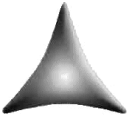
GOING BEYOND THE CURIES
by Bruce A. Perreault 02/16/02
The residues of the uranium extraction process were discarded as valueless for years until the discovery of radium by Madame Curie. In her analysis of the radioactive constituents of pitchblende, the ore was first fused with sodium carbonate and then dissolved in hydrochloric acid. The metals of the lead group in the pitchblende, such as lead, copper, and bismuth, were removed by precipitation with hydrogen sulfide. The remaining metals, such as iron and zinc were also removed by precipitation with suitable agents. A radioactive element combined with bismuth was isolated. It was called "Polonium" in honor of Madame Curie's native country.
A mixture of barium and radium chlorides remained in solution. After the removal of the metals of the first two groups, the last and most tedious process of extraction was to obtain the radium chloride as free as possible from the barium chloride.
The Curie process of extraction of radium chloride from barium chloride is called "fractional crystallization." This method depended upon the fact that radium chloride is less soluble in water than barium chloride. Therefore, if a mixture of these two chlorides is dissolved in water or alcohol, the first crystals that are deposited are richer in radium than those that remain within the solution. These first crystals are the richest in radium.
The first crystals are collected, are again dissolved, allowed to crystallize and collected as before. The cycle was repeated many times until the crystals became practically free from the barium. When the purest radium chloride was obtained its intensity was about 1,500,000 times that of uranium.
* Excerpts taken from "RADIUM: and other Radio-active Elements" by L. A. Levy and H. G. Willis; Percival Marshall & Co., p. 17 - 21.
Madame Curie's process was very time consuming and the barium was never completely removed. Only small amounts of radium could be obtained, making it a very rare substance. To this day there are very small inventories of this substance, making the cost prohibitive for research and practical applications. The Curie process of extraction, being so long and so difficult, has made radium research impractical to this day.
The method that I use to extract uranium, thorium, and radium from their parent ores is the opposite of the Curie Process. Instead of evaporating the barium solution, super saturation is used to form the doublesalts. My crystallization process takes only a few minutes whereas the Curie process takes a few months. This makes possible a new era of radium research. My method also opens a doorway to producing uranium and thorium more economically, without the normally associated hazardous and wasteful by-products.
Until now, none have thought to drive off the barium with heat. This is due to the rarity and expense that has been associated with its radium salts. The final heat treatment yields a pure oxide. There is no barium that is left behind. We now can study the true nature of what has been dubbed "radium."
Great strides have been made with the discovery of my process. However, there is more work to be done. The barium that is manufactured today consists of seven non-radioactive stable isotopes. We need to isolate each isotope. Each individual isotope needs to be used in my process and the results must be clearly documented. What I suspect is that an individual barium isotope will cling to a specific target, be it uranium, thorium, or radium. This hypothesis is based on adding the atomic weight of helium (He4) to the weight of one of the barium isotopes. We add four units until we hit our target metal that we want to extract.
The chart below is subject to change with further research. If I am correct about this target hypothesis, then it is not too difficult to envision how these targets form in the earth. Hasn't anyone ever wondered why the U235 atom "splits" leaving behind a short lived radioactive isotope of barium? The chart presented here might explain the event. What other discoveries are to be found with all of the other elemental isotopes not even discussed here? Will we now be able to isolate undiscovered elements? Unfortunately, I do not have the funds to continue with this line of research. Hopefully, some university lab will carry the torch and give me credit for this original discovery.
|
Isotope |
Percent found in Nature |
Targets |
|
Ba130 |
0.101% |
Ra226 U234 U238 |
|
Ba132 |
0.097% |
Ra224 Th228 Th232 |
|
Ba134 |
2.42% |
Ra226 U234 U238 |
|
Ba135 |
6.59% |
Ra223 U235 |
|
Ba136 |
7.81% |
Ra224 Th228 Th232 |
|
Ba137 |
11.32% |
unknown |
|
Ba138 |
71.66% |
Ra226 U234 U238 |
Chart - 1
Reference
 ™
™
Nu Energy Technologies Research
& Development Webpage
Nu
Energy Horizons, P. O. Box 22, Rumney, New Hampshire 03266-0022 USA
Copyright © 2002, All
Rights Reserved

